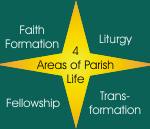Little is known about three mysterious visitors
They came. They saw. They gifted. That’s about all we know of the foreign visitors who travelled to Bethlehem to see the infant Jesus. The scene ingrained in the public imagination – a stately procession of three kings in turbans, crowns, elaborate capes and fancy slippers, with an entourage of servants and camels trailing behind – isn’t from Scripture. In fact, there’s no evidence in the Gospels that the Magi were kings, or even that there were three of them, much less that they sidled up to a manager on dromedaries exactly 12 days after Jesus’ birth.
“Legends pop up when people begin to look closely at historical events,” said Christopher Bellitto, assistant professor of history at New Jersey’s Kean University. “They want to fill in the blanks.” Only the Gospel of Matthew mentions “wise men from the East” who follow a star to Bethlehem. In the original Greek, they were called magoi (in Latin, magi); from the same root that gives us the word magic. It’s been posited they were astrologers or members of a Persian priestly caste.
But what matters more than their exact number and status, say historians and biblical scholars, is the fact that they were not Jews. “For Matthew, the magic star leading the wise men to the place of Jesus’ birth is his way of saying what happened in Jesus is for the gentile world as well,” said Marcus Borg, professor of religion and culture at Oregon State University and co-author of the new book, The First Christmas. After being warned in a dream to avoid the murderous King Herod, the Magi returned home “by another road.” Metaphorically, that suggests they were transformed by their experience. While Matthew doesn’t say they converted to Christianity, popular legend holds that they were baptized by St. Thomas and died in Armenia in AD 55.
The first artistic depictions of the Magi are found in second century Roman catacombs, but it wasn’t until the early third century, when Christian writer Tertullian referred to them as “almost kings,” that they began to cultivate a royal air. Their kingly designation also echoes biblical passages in Isaiah and the Psalms, keeping with the common belief that Jesus’ birth was predicted in the Old Testament. Prophecies foretold gifts of gold and frankincense, two of the three gifts the Magi brought. The third, myrrh, was a burial spice, which some believe foreshadowed Jesus’ death and resurrection.
Around the same time as Tertullian, Origen – a theologian in Alexandria, Egypt – set their number at three, likely because they carried three gifts, said Teresa Berger, a professor at Yale Divinity School. Later, the wise men were portrayed as representatives of the three races of man as descended from Noah’s sons – Semitic, Indo-European, and African – which is why one is sometimes pictured as a black man. Fast forward to the sixth century, when a Latin document recorded their names as Gaspar (or Caspar), Melchior, and Balthazar, though the source is unknown, and different names exist in other languages.
By the time their relics arrived at the Cologne cathedral in 1164, after stops in Constantinople and Milan, the faithful venerated the Magi as saints, and festivals sprang up to honour them. A 14th century report of an Epiphany play described costumed “kings” riding through Milan on horseback with a large retinue, similar to contemporary three kings parades in Latin America and in Latino communities in the United States.
Today, Roman Catholics and some Protestants commemorate the Magi’s visit on Jan. 6 with the Feast of the Epiphany. Orthodox Christians celebrate both Jesus’ birth and the adoration of the Magi together, either on Dec. 25 or Jan. 7, depending on which calendar they follow; Jan. 6 or 19 marks Jesus’ baptism, also called Theophany. “All of those are revelations, which is basically what the ‘phany’ in Epiphany and Theophany means – an unveiling,” said Rev. Andrew Ciferni, a Norbertine priest at Daylesford Abbey in Paoli, Penn. “With the three kings, it’s the revelation of salvation to the gentiles.”
In Europe and Latin America, where Jan. 6 remains a holiday in some places, Epiphany folk customs abound. The elderly Befana and Babushka bring gifts to Italian and Russian children, while in Puerto Rico, the “tres reyes” are said to deposit presents in children’s shoes, often in exchange for oatmeal or hay left out overnight for their camels. In Germany, where Berger grew up, children dress up as kings and process from house to house, collecting money for the poor, while French bakeries serve galette des rois, or kings’ cake. In a handful of countries, people still mark their homes in chalk with the initials of the three wise men, CMB, which also stands for “Christus Mansionem Bendicat,” or ”May Christ bless this house.”
The Magi may get short shrift in North America compared to other parts of the world, but they play an integral part of the Christmas story, cropping up in songs and often stealing the show in pageants. William Studwell, a retired professor at Northern Illinois University and an expert on Christmas carols, chose We Three Kings of Orient Are as one of two carols of the year for 2007 to mark its 150th anniversary. He recalls his own Magi days fondly. “It’s one of the only things I remember about third grade,” he said, being one of the kings.”
|



